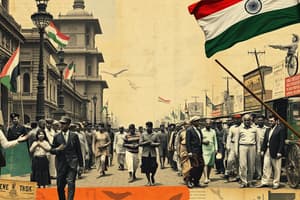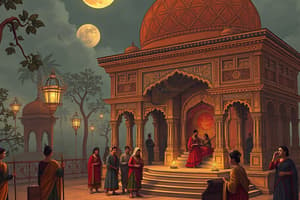Podcast
Questions and Answers
What was the main goal of the Quit India Movement launched by Mahatma Gandhi?
What was the main goal of the Quit India Movement launched by Mahatma Gandhi?
- To support British colonial rule
- To demand Britain's immediate withdrawal from India (correct)
- To gain independence from Japan
- To expand British control over India
Why was the Quit India Movement considered unique among previous nationalist movements?
Why was the Quit India Movement considered unique among previous nationalist movements?
- For focusing on gaining independence from Japan
- For being a peaceful protest movement
- Due to its scale, intensity, and level of violence (correct)
- Because it supported British colonial rule
What global event provided an opportunity for Indian nationalists to launch the Quit India Movement?
What global event provided an opportunity for Indian nationalists to launch the Quit India Movement?
- The Korean War
- The Second World War (correct)
- The Cold War
- The Vietnam War
Which phrase did Gandhi originally use to describe the movement before adopting 'Quit India'?
Which phrase did Gandhi originally use to describe the movement before adopting 'Quit India'?
What was Gandhi's simple call to action to the people during his speech to the AICC?
What was Gandhi's simple call to action to the people during his speech to the AICC?
Why did the Congress leadership get arrested during the Quit India Movement?
Why did the Congress leadership get arrested during the Quit India Movement?
What was the name of the parallel government formed by local Congress leaders in Bengal during the Quit India Movement?
What was the name of the parallel government formed by local Congress leaders in Bengal during the Quit India Movement?
How did the British administration respond to the Quit India Movement?
How did the British administration respond to the Quit India Movement?
What was a consequence of the Quit India Movement's scale and violence in Bengal?
What was a consequence of the Quit India Movement's scale and violence in Bengal?
Which newspapers were censored and banned by the British during the Quit India Movement?
Which newspapers were censored and banned by the British during the Quit India Movement?
What role did the Quit India Movement play in the eventual independence of India?
What role did the Quit India Movement play in the eventual independence of India?
What is one reason why the Quit India Movement is considered a defining moment in Indian history?
What is one reason why the Quit India Movement is considered a defining moment in Indian history?
Flashcards are hidden until you start studying
Study Notes
The Quit India Movement
On August 8, 1942, during the All-India Congress Committee session in Bombay, Mahatma Gandhi launched the 'Quit India' movement, a bold campaign demanding Britain's immediate withdrawal from India. Despite numerous previous nationalist movements, Quit India was unique in its scale, intensity, and the level of violence it engendered.
Origins and Motivation
The Quit India Movement arose amidst the Second World War, with Indian nationalists and revolutionaries exploiting the shifting global political landscape. The British Empire's vulnerabilities, as well as the Japanese Army's advancement towards India's eastern border, fueled Indian hopes that Britain might be forced to retreat. Indian nationalists, including Gandhi, Subhas Chandra Bose, and other prominent figures, believed the war could weaken British control, and they aimed to exploit this weakness.
Gandhi's Call to Action
Gandhi's initial phrase for the movement was 'an orderly British withdrawal,' but he later adopted the more incendiary term 'Quit India' popularized by an American journalist. Gandhi's speech to the AICC on August 8, 1942, articulated his intention to transform the Congress from a political organization into a mass movement, with a simple call to "Do or Die." The Congress leadership was subsequently arrested, leaving the movement to be driven by local forces.
The Movement's Reach
The Quit India Movement was a pan-Indian phenomenon, with a particular impact in Bengal, Bihar, Orissa, and Maharashtra. In Bengal, local Congress leaders such as Subhas Chandra Bose formed a parallel government, the Tamralipta Jatiya Sarkar, which implemented a parallel administration in places like Midnapore. The movement's scale and violence led to the British response being described as the "Great Calcutta Killing" and "Operation Searchlight."
The British Response
The British administration responded with intense repression, banning the Congress Party and jailing its leaders. The press, too, was censored and banned, with newspapers like the Statesman, the Times of India, and The Hindu edited to support government policies. The Quit India Movement also witnessed the retaliation of Congress supporters and the violence of the radical revolutionary groups.
Legacy
The Quit India Movement was a failure in terms of its immediate goals. However, it played a pivotal role in the eventual independence of India in 1947. It demonstrated the strength of Indian nationalist sentiment and the weakness of British rule, factors that influenced the eventual withdrawal of the British from India.
The Quit India Movement remains a defining moment in Indian history, a powerful example of mass civil disobedience and the determination of the Indian people to gain their freedom from foreign rule.
Studying That Suits You
Use AI to generate personalized quizzes and flashcards to suit your learning preferences.




